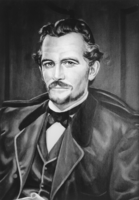 | Back to e-WV
| Back to e-WV
 The West Virginia Encyclopedia
The West Virginia Encyclopedia
 | Back to e-WV
| Back to e-WV
 The West Virginia Encyclopedia
The West Virginia Encyclopedia

William Erskine Stevenson (March 18, 1820-November 29, 1883) was West Virginia’s third governor. He was born in Warren, Pennsylvania, and as a young man, he became an apprentice cabinet maker in Pittsburgh. In 1856, he was elected as a member of the Pennsylvania legislature. However, he moved to Wood County, (West) Virginia, before his first term ended and bought a farm.
As the Civil War approached, Stevenson was a strong believer in the Union. While advocating for the cause, he was indicted by a Parkersburg grand jury for ‘‘circulating an incendiary document entitled Helper’s Impending Crisis.’’ He never did go to trial. Stevenson represented Wood County at the first constitutional convention of 1861. After the state of West Virginia was created, he served in the first state senate. He was elected senate president for three of the five years he was in the legislative body.
In 1868, Stevenson was elected as the third governor of the new state. Stevenson, a Republican, beat out Johnson Newlon Camden, another Parkersburg man, by about 5,000 votes in the general election.
Stevenson was the first governor to have an office in Charleston. However, he occupied the new capitol for only about three months. As governor, Stevenson encouraged the legislature to build more roads to encourage economic growth. In addition, he stood for immigration, educational opportunities for blacks, and the right to vote for former Confederates and Southern sympathizers who had been disenfranchised following the war. He and some others believed, wrongly as it happened, that if the vote were restored the Southern sympathizers would join liberal Republicans in providing moderate government in West Virginia. The Flick Amendment passed during Stevenson’s term, restoring the Southern vote and ushering in a long period of Democrat rule.
Stevenson lost his bid for a second term when he was defeated by Democratic candidate John J. Jacob in the general election of 1870. Shortly after Stevenson left office, he became involved in the publication of the State Journal, a weekly newspaper headquartered in Parkersburg. He published the newspaper for approximately 10 years until he sold it to A. B. White (who later became governor as well). After the sale, Stevenson became associated with the West Virginia Oil and Land Company.
Stevenson worked primarily in farming, journalism, and business. He died at the age of 63. The cause of his death was believed to be cancer. He left behind his wife, the former Sarah Clotworthy of Philadelphia, and two children (a son, Orlando, and a daughter, Carrye A.). He is buried in Riverview Cemetery in Parkersburg.
Written by S. Shuan Butcher
Morgan, John G. West Virginia Governors, 1863-1980. Charleston: Charleston Newspapers, 1980.
Allen, Bernard L. Parkersburg: A Bicentennial History. Parkersburg Bicentennial Commission, 1985.
National Cyclopaedia of American Biography. New York: J. T. White, 1892.
Casdorph, Paul D. The 1872 Liberal Republican Campaign in West Virginia. West Virginia History, (July 1968).